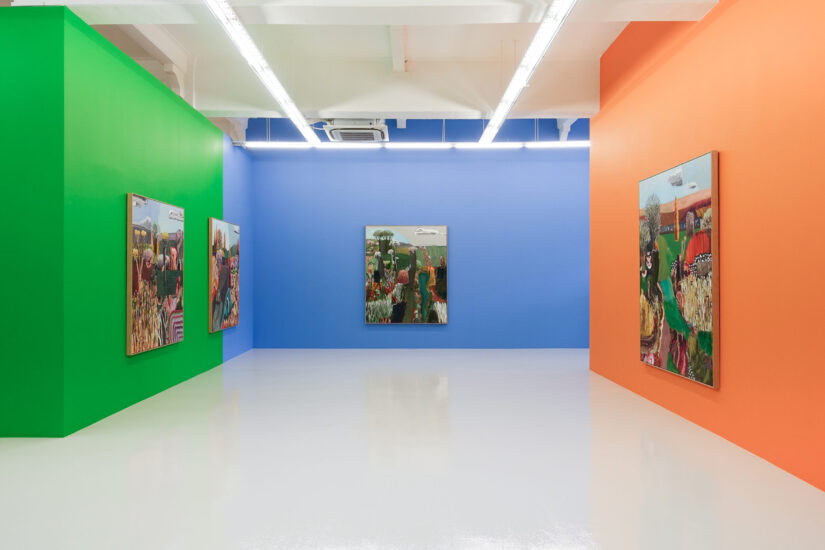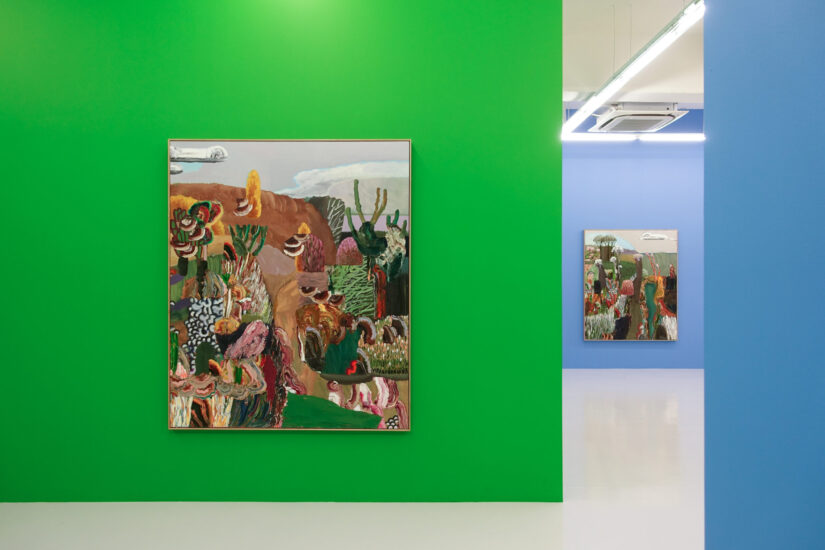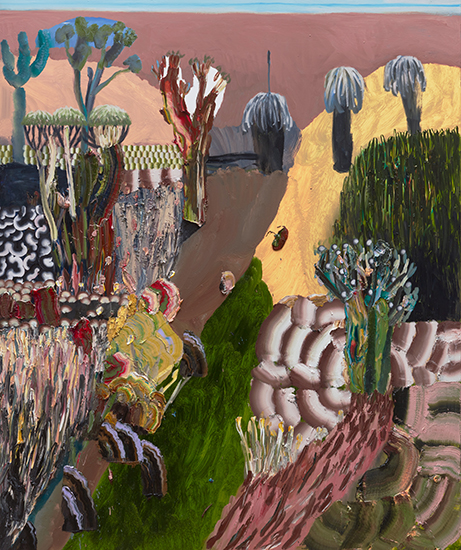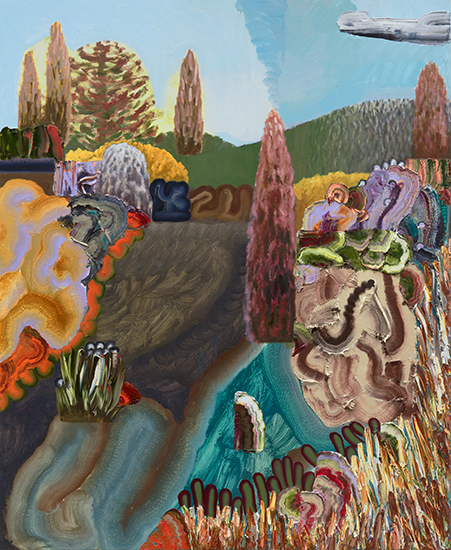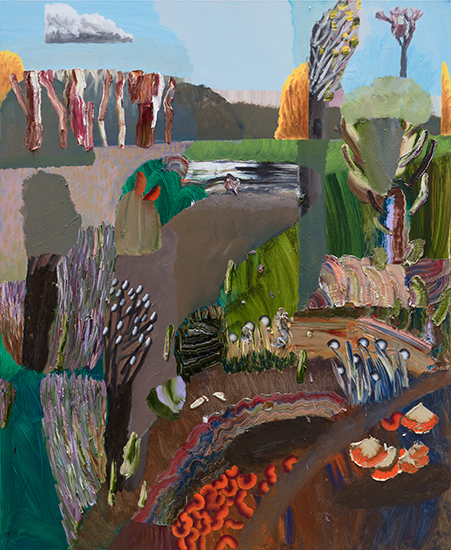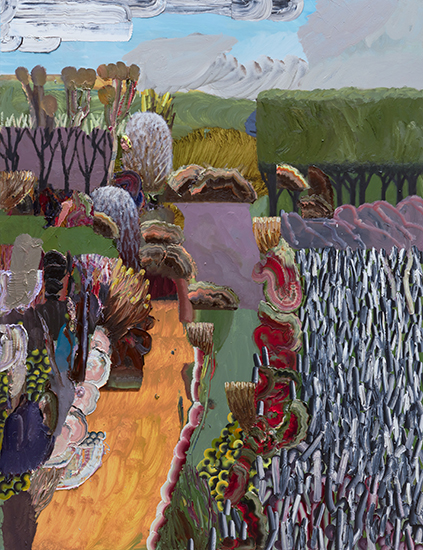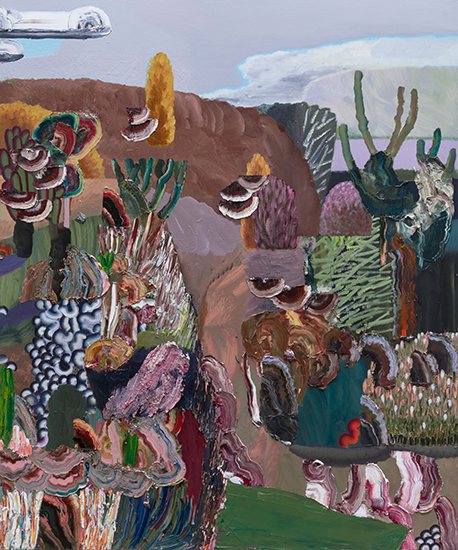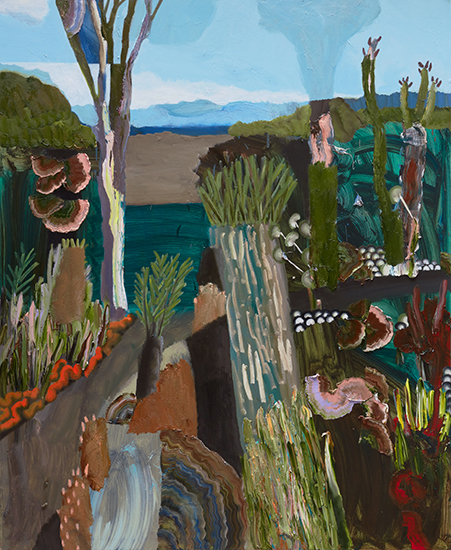WOLLEMIA
‘It requires something of a balancing act to conjure “not an endless expanse of unfathomable time, but a series of worlds, simultaneously fabulous yet familiar”. On the one hand, there is the recognisable – rivers flow, forests grow, life adapts, creatures die. On the other, there is the frisson of sheer weirdness.’ [1]
In his recent book, Paleobiologist Thomas Halliday invites us to experience ancient landscapes and lost ecosystems of the past as we experience the reality of nature today. Halliday enables us to see the last 550 million years not as an ‘endless expanse of unfathomable time, but a series of worlds, simultaneously fantastical and familiar’[2]. Like Halliday’s Otherlands, Guido Maestri’s paintings are simultaneously fantastical and familiar. Instinctively drawing on sites from his past; an index of conditioned landscapes, Maestri realises new ones in the form of painted worlds and fantastical realms. Maestri borrows the exhibition’s title from the critically endangered Australian species Wollemia nobilis, commonly known as the Wollemi Pine. This coniferous tree was thought long extinct and known only as fossils before a chance discovery in 1994 in the Blue Mountains of New South Wales, Australia. The discovery of this ‘living dinosaur’ is regarded as one of the great biological reincarnations of all time. [3]
During the production of Wollemia Guido experienced Halliday’s Otherlands on audiobook. The coincidence of this intersection is somewhat uncanny but incredibly aligned. Both bodies of work are concerned with reflecting nature’s cycles and depicting ancient ecosystems, and both present, and perform, landscapes simultaneously historic and imaginary. They dance between reality and narrative, challenging us to determine what is factual and what is fictional; though Halliday assures us that every description, whether ‘the colour of a beetle’s shell or the rhythm of pterosaurs in flight or the lingering smell of sulphur in the air’ is grounded in fact.
Maestri’s paintings are self-referential. They refer to the inevitable context and time in which they exist; a time of human-caused climate chaos and ecological devastation. Figures are evidently absent, but the impact of human beings on the landscape is undoubtedly implied and perhaps even emphasised. Light bounces off manicured hedges, cut grasses and trimmed trees, and central pathways act as entry points into the works, choreographing the viewer through the paintings. In his 2011 lecture “Do Landscapes have identities?” T.J. Clarke suggests ‘historically, it is a convention of landscape painting to consider the viewer’s entry point into a depicted world, be it a pathway, an open gate, a clearing.’ Maestri’s paintings may be considered historical, in the way they draw on past places [4], but it’s hard to believe they are conventional. In fact, they signify and celebrate Guido’s eagerness to move away from convention; to break away from what Hockney calls ‘the trap of naturalism’. I recently learned Wallace Steven’s poem “The Man with the Blue Guitar” (after Picasso’s 1904 painting “The Old Guitarist”) was one of the precursors for Hockney’s shift away from naturalism. Maestri’s shift correlates with his move away from painting in the field to working exclusively in his Marrickville studio.
These recent paintings are made inside of outside. They celebrate the natural world yet reveal modern culture’s increasing disconnectedness from it. Maestri speaks of no longer needing to ‘go into the landscape to find a Bunya Pine’ when he can choose one to reference from the hundreds he summons to the screen of his handheld device whilst in the studio. This reminds me of Robert Macfarlane’s The Lost Words, a book that reinstates and restores words (relating to nature) that are disappearing from children’s dictionaries and being overwritten. Words like dandelion, otter, acorn, and lark are being replaced with those like broadband, blog, chatroom, and megabyte.
Wollemia confronts us with a visceral, immediate, and sophisticated arrangement of paint and invites us to consider our relationship to, and experience of, the natural world. These paintings remind me of European gardens on Aboriginal land. They represent a clash of worlds; real and imagined, ancient and modern, pre-colonial and post-colonial, native and foreign, familiar and unfamiliar and as Gombrich states in Art and Illusion ‘the familiar will always remain the likely starting point for rendering the unfamiliar’ [5].
– Sally Anderson
[1] Otherlands: A Journey Through Earth’s Extinct Worlds, Goodreads, accessed July 20, 2022
[2] Thomas Halliday, Otherlands: A World in the Making, 2022
[3] Meet the Wollemi pine, the ‘dinosaur tree’ brought back from the dead and threatened once again, Washington Post Article by Adrian Higgins, 2020
[4] Stella Rosa McDonald, Paintings on Paintings, 2017
[5] E.H.Gombrich, Art and Illusion: A Study in the Psychology of Pictorial Representation, 1960
